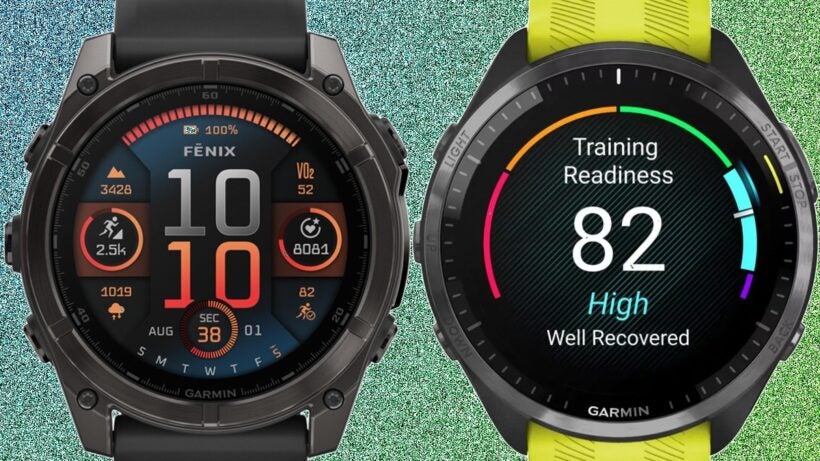Which AMOLED-packing Garmin should you go for? Here are our recommendations after testing.
Garmin’s collection of AMOLED sports watches has rapidly expanded over the last couple of years, with the Fenix 8 the latest to join the ranks alongside the Forerunner 965 and Forerunner 265 released in 2023.
All three of these sports watches have performed extremely well in our review testing, whether in tracking accuracy, training analysis, or battery life. It means picking between the trio is a tricky task – and, really, the decision boils down to budget and the level of features you require from your AMOLED Garmin.
The Fenix 8 range is the most expensive option available, showcasing the peak of the brand’s tracking capabilities in a robust, premium design. If you’re a multi-sport athlete who enjoys a wide array of features and needs something ready for outdoor adventures (and can afford one of the various models on offer), this is the ideal choice.
Alternatively, Forerunner devices—whether the top-of-the-range 965 or mid-range 265—are primarily geared toward those looking to enhance their training in the core triathlon disciplines: running, cycling, and swimming.
Beyond these broad facts, there’s much more to grasp, which is why we’ve compared these models to assist you in making a choice. Let’s dive in.
Specs comparison
| Garmin Fenix 8 AMOLED (47mm) | Garmin Forerunner 965 | Garmin Forerunner 265 | |
| Case size options | 43mm, 47mm and 51mm | 47mm | 42mm and 46mm |
| Waterproof rating | 100 metres and 40 metres (diving) | 50 metres | 50 metres |
| AMOLED screen | 1.4-inch , 454 x 454 | 1.4-inch , 454 x 454 | 1.1, 360 x 360 or 1.3, 416 x 416 |
| Dual-frequency GPS | Yes | Yes | Yes |
| Full-color maps | Yes | Yes | No |
| Navigation and route import | Yes | Yes | Yes |
| Battery life | Up to 16 days (47mm) | Up to 23 days | Up to 13/15 days |
| GPS battery life | Up to 35 hours | Up to 31 hours | Up to 20-24 hours |
Price and versions
In true Garmin style, there are numerous options to choose from here – but the Forerunner models offer a more limited selection of sizes and styles.
The 265 offers case sizes of 42mm (265s) or 46mm (265), while the 965 is only available in a single case size of 47mm. This corresponds to the middle size of the Fenix 8.
Garmin’s latest Fenix is available in 43mm, 47mm, and 51mm sizes if you choose the AMOLED Fenix 8, or you can select between 47mm and 51mm for the solar-powered, non-AMOLED version.
For pricing, the 265 is the most affordable, with all versions priced at £429.99/$449.99. Next is the Garmin Forerunner 965, at £599.99/$599.99. Then we move on to the Fenix 8 and its many models.
Pricing for a Fenix starts at £949/$999, but it can expand to $1,199/£1,039 if you choose the 51mm AMOLED Fenix, which essentially offers the largest battery of all the model sizes (more on that later).
It seems odd to discuss value for money with such high prices attached to these watches, but the 965 feels like it mostly hits the sweet spot in terms of features at that still high cost.
- Winner: Garmin Forerunner 965
Design, display, and build

We know these are Garmin watches with color screens, and across the board, they feature great quality AMOLED displays. The differences lie in what’s wrapped around them.
The main concern for us has been the protection against scratches on these screens. The 965 and 265 use versions of Corning’s Gorilla Glass, while the Fenix 8 offers either Corning’s scratch protection or the tougher sapphire crystal. During our testing, we easily picked up scratches on the 965, so if you plan to use these watches ruggedly, the Fenix will provide a bit more support in that area.
That extends to the case, where it’s polymer throughout, with Garmin adding metal for the rear of the case and providing the choice of steel or titanium bezels for the Fenix 8. The 965 also uses titanium for the bezel, which gives it a slightly nicer look than the 265. Still, this lower model brings a sleek, sporty style that’s great for exercise.

As expected, the difference in materials and sizes impacts the weight. Our 51mm Fenix 8 weighs 92g, compared to 53g (965) and 39g (265s). Of course, if you opt for a smaller size with the Fenix, things will get lighter, but it’s undeniably the larger watch to live with.
Where the Fenix wins
Yet, the Fenix 8 offers more in terms of durability. It has a 10 ATM (up to 100 meters) waterproof rating, compared to the 5 ATM (up to 50 meters) rating on the 965 and 265. Additionally, the Fenix includes leakproof inductive buttons, ensuring it is safe for recreational diving up to 40 meters.
The Fenix 8 also has an LED flashlight in its locker. While we initially thought this addition was a bit of a gimmick when it was introduced en masse in the last-gen Fenix 7 Pro/Epix Pro models, we have actually found it very useful in longer-term testing. It’s also something the 965 and 265 both miss out on.
- Winner: Garmin Fenix 8
Smart features and OS

These Garmin watches operate on the company’s proprietary operating system, compatible with Android and iPhones, providing a consistent experience across these two platforms.
As smartwatches, they all work well. They display notifications nicely and offer features like Garmin Pay and weather forecasts, Connect IQ Store access, and built-in music players for offline playback from apps like Spotify.
While the experience is the same, keep storage in mind when choosing between these models. The 265 offers the least storage (8GB vs 32GB available on Fenix 8/965), so there is less room for apps and audio files.
The significant differences are in the UI changes Garmin has made to the Fenix 8, and it’s unclear whether those changes will be available on the 965 and 265. Additionally, the Fenix includes new voice features, allowing you to make Bluetooth calls, summon your smartphone’s smart assistant, record voice notes, and control your watch without pressing a button.
How important those features are in day-to-day use will depend on the user; however, aside from those voice capabilities, there’s little to differentiate this trio of Garmins in the smart features department.
- Winner: Garmin Fenix 8
Battery life

Battery life is a significant factor when you include an AMOLED screen. Whether the always-on mode is enabled or not, it will drain the battery faster than Garmin’s transflective, memory-in-pixel displays. It’s also important to remember that the latter, more power-efficient displays are available as part of the Fenix 8 range (but not the 965 or 265).
When using these three watches under roughly the same testing conditions, which include enabling the AOD, our experience has shown that the 965 typically lasts around 6-7 days. The 265, meanwhile, lasts around 4 days. Both, it should be noted, can comfortably last over a week if you disable the AOD.
With the Fenix 8, we’ve been testing the largest 51mm AMOLED option, and the battery has lasted us for weeks. Garmin claims it can last anywhere from 29 to 48 days. The 965 promises 23 days, and the 265 offers 13 days. Again, this will depend on usage of key features, but the Fenix 8, whichever model you choose, is bound to provide you with more.
The same applies to GPS battery life. In the highest accuracy mode, the Fenix 8 lasts for up to 62 hours, while the 965 is limited to 19 hours and the 265 even less at 16 hours. These should adequately support regular GPS use throughout the week and have less impact on the Fenix 8’s battery reserves.
- Winner: Garmin Fenix 8
Tracking performance

These are all multisport watches at heart, with the 965 and 265 offering a more running-focused edge, while the Fenix 8 enhances adventure tracking capabilities.
It’s a watch suitable for diving, capable of tracking a wider range of outdoor sports, and offering a richer mapping experience.
The good news is that from an accuracy perspective, all three have performed well for us, particularly regarding GPS. Each device offers Garmin’s latest Multi-Band GNSS mode, which results in some of the best tracking accuracy we’ve discovered on a sports watch.
All devices have optical heart rate sensors and support pairing with external HR sensors. However, if you prefer not to do that, we’ve found the smaller 265 performed best in our heart rate tests.

Sports modes and mapping comparison
Regarding watches for maps and navigation, the 965 and the Fenix 8 offer full mapping support, while the 265 provides breadcrumb-style navigation and the ability to upload routes. Both options function well, but if this feature is essential to you, we always recommend choosing the native mapping experience.
The mapping support on the 965 and Fenix 8 is quite similar, particularly given that they feature screens of the same size and resolution, with the Fenix 8 only adding ski resort maps and some additional tide information. If you plan to use them for activities like running and hiking, the experience across the map-supporting Garmins should suffice for your needs.
In the core sports modes, the 265 also misses the golf mode available on the 965, although even the latter’s golf support is not as detailed as the Fenix 8’s. The Forerunner models also lack insights such as heat and altitude acclimation, endurance scores, and real-time stamina metrics.
Ultimately, they all provide a good balance of tracking accuracy, analysis, and supported sports. You’re not likely to choose these watches for health or general wellbeing tracking, yet we’ve found all three quite competent for continuous heart rate and stress monitoring, with similar results for sleep tracking. It can be inconsistent at times, but Garmin’s sleep tracking has generally improved.
- Winner: Garmin Forerunner 965
Verdict: Which is best in 2025?
So, that’s how we got on with testing the Fenix 8, Forerunner 965, and Forerunner 265. Which of these Garmins should you consider? Here’s our take:
- Choose the Garmin Fenix 8 if you want the toughest AMOLED-packing watch with standout tracking, more advanced smartwatch features, and weeks of battery life.
- Buy the Garmin Forerunner 965 if you want features like good GPS accuracy, full mapping and Garmin’s best training features at a more affordable price than the Fenix 8.
- Go for the Garmin Forerunner 265 if you want a Garmin AMOLED watch with good wrist-based HR performance, a smaller design and roughly a week of battery between charges.
- Also, consider the Garmin Forerunner 165 if you’re set on a Garmin with a colour screen and want good tracking, some navigation support, and solid battery life on a budget.




